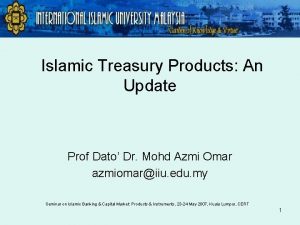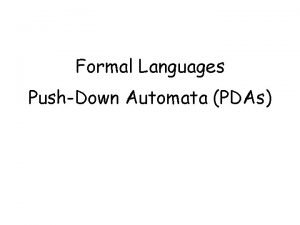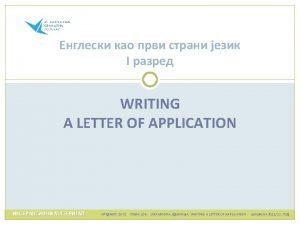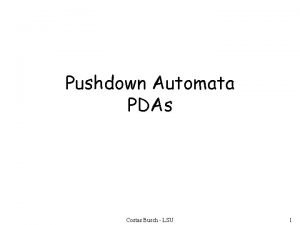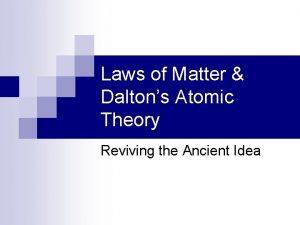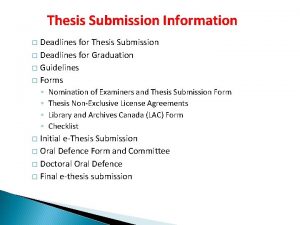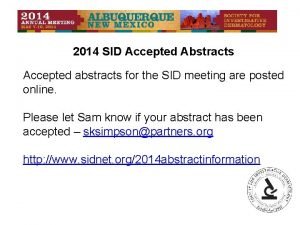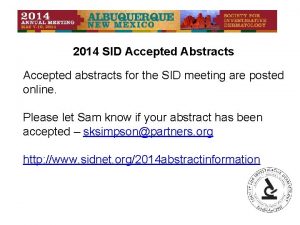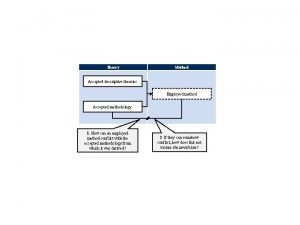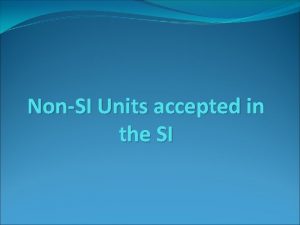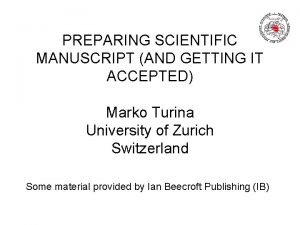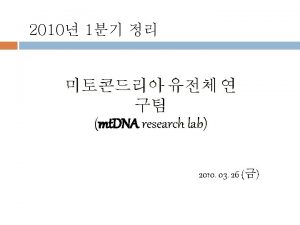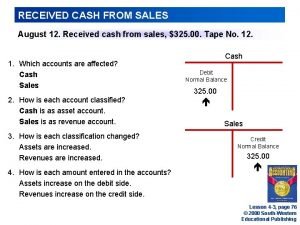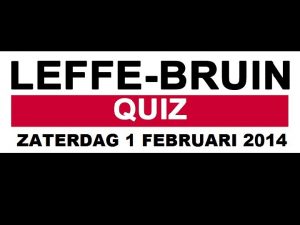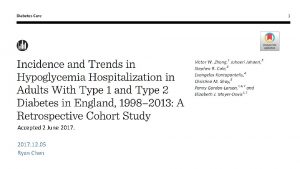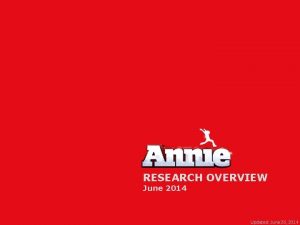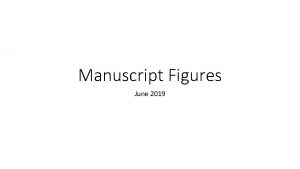Manuscript Received 5 June 2014 Manuscript Accepted 18

























- Slides: 25


Manuscript Received: 5 June 2014; Manuscript Accepted: 18 December 2014 Accepted manuscript online in Wiley Online Library (wileyonlinelibrary. com): 23 December 2014

Abbreviation: PPARγ, Peroxisome proliferator activated receptor γ; a. P 2, Adipocyte fatty acid-binding protein 4; FAS, Fatty acid sythetase; Notch 1, Notch homolog 1; Hey-1, Hairy/enhancer-of-split related with YRPW motif 1; IRS 1, Insulin receptor substrate 1; Hes-1, Hairy and Enhancer of split 1; Pref-1, Preadipocyte factor 1; PI 3 K, phosphatidylinositol-4, 5 -bisphosphate 3 -kinase; AKT 1, AKR mouse T-cell lymphoma oncoprtein;

Abbreviation: mmu, Mus musculus; 小鼠 mml, Macaca mulatta; 猕猴 ssc, Sus scrofa; 野猪 rno, Rattus norvegicus; 褐家鼠 hsa, Homo sapiens; 智人 cgr, Cricetulus griseus; 灰仓鼠 ppy, Pongo pygmaeus; 猩猩 eca, Equus caballus. 马

研究背景 Adipocyte differentiation is a dynamic and complex process, including clonal expansion, cell cycle exit and terminal differentiation into mature adipocytes (Rosen and Spiegelman. , 2000; Feve, 2005). Recent researches have indicated that mi. RNAs play some roles in regulating adipocyte differentiation (Li et al. , 2013). mi. R-143 mi. R-103 mi. R-30 c mi. R-375 mi. R-155 mi. R-224 let-7

Interestingly, although most studies have focused on the role of mi. R-139 – 5 p as a tumorigenic inhibitor, little is known about its role in adipocyte differentiation. Our previous work using high throughput sequencing identified that the expression level of mi. R-139– 5 p in adipose tissue from 240 -day old Rongchang pigs was 2. 2041 folds higher than that of 7 -day-old piglets (Li et al. , 2011). The expression pattern of mi. R-139– 5 p suggested that it might be involved in adipogenesis.

研究目的 To explore the role of mi. R-139– 5 p in 3 T 3 -L 1 adipogenic differentiation, we overexpressed mi. R-139– 5 p in 3 T 3 -L 1 preadipocyte. The results showed thatmi. R-139– 5 p impaired adipocyte clonal expansion to inhibit the differentiation. Further evidence demonstrated that mi. R-139– 5 p suppressed 3 T 3 L 1 preadipocyte differentiation through Notch signaling and IRS 1/PI 3 K/Akt insulin signaling.

材料和方法 1. ANIMAL STUDIES 2. CELL CULTURE 3. TRANSFECTION OF MIRNA MIMIC 4. BIOINFORMATICS ANALYSIS 5. 3’UTR LUCIFERASE REPORTER ASSAYS 6. PLASMID CONSTRUCTION AND TRANEFECTION

材料和方法 7. OIL RED O STAINING AND EXTRACTION 8. REAL-TIME QPCR 9. WESTERN BLOTTING ANALYSIS 10. FLOW CYTOMETRY 11. EDU INCORPORATION ASSAY 12. STATISTICAL ANALYSIS

FLOW CYTOMETRY 3 T 3 -L 1 cells were seeded in 60 mm dishes. 24 h later after seeding, cells reached confluence and were transfected by mi. R-139– 5 p mimic or mi. R-NTC using X-treme. GENE HP DNA Transfection Reagent. 3 T 3 -L 1 cells were harvested by trypsin digestion on day 2 of differentiation, and washed three times with PBS to remove cell debris. The cells were then fixed in cold 70% ethanol overnight, treated with 1 mg/m. L RNase A for 40 min at 37°C, and then stained with 20 mg/m. L propidium iodide (PI). The cells were analyzed using a FACScan argon laser cytometer.

EDU INCORPORATION ASSAY Ed. U labeling was used to detect DNA synthesis. 3 T 3 -L 1 cells from each group were cultured in 96 -well plates and treated with Ed. U (30 mg/m. L) for 3 h before fixation. Then medium was removed and Ed. U incorporation was measured using the Click-i. T Ed. U Alexa Fluor 594 Imaging Kit (Invitrogen). Finally, the cells were examined using a Nikon TE 2000 microscope (Nikon, Tokyo, Japan). Ed. U (5 -乙炔基-2’脱氧尿嘧啶核苷)也是一种胸腺嘧啶核苷类似物,但其 连有的炔羟基团在天然化合物中很少见,在细胞增殖时能够插入正在复制的 DNA分子中,基于Ed. U与染料的共轭反应可以进行高效快速的细胞增殖检测 分析,可以有效地检测处于S期的细胞百分数。


We speculated that this transient decrease in mi. R-139– 5 p expression might be related with clonal expansion (see below). Fig. 1. Expression of mi. R-139– 5 p in mouse tissues and during 3 T 3 -L 1 preadipocyte differentiation. A: Mature mi. R-139– 5 p sequence is conserved among species. Expression of mi. R-139– 5 p was surveyed by real-time q. PCR at the time points indicated in six different mouse tissues (B) and during 3 T 3 -L 1 cell differentiation.

Fig. 2. Mi. R-139– 5 p impairs 3 T 3 -L 1 cells differentiation

These data indicated that mi. R-139– 5 p inhibited 3 T 3 -L 1 preadipocyte differentiation. Fig. 2. Mi. R-139– 5 p impairs 3 T 3 -L 1 cells differentiation

Fig. 2. Mi. R-139– 5 p impairs 3 T 3 -L 1 cells differentiation

when mi. R-139– 5 p was overexpressed, the fraction of S-phase cells descended (P<0. 01) while G 0/G 1 phase proportion increased (P<0. 01), indicating that mi. R-139– 5 p led to a cell-cycle delay. Fig. 3. Mi. R-139– 5 p impairs the clonal expansion of 3 T 3 -L 1 cells.

Ed. U incorporation showed relative positive cells were reduced (P<0. 01) after mi. R-139– 5 p mimic transfection these data supported that mi. R-139– 5 p impaired clonal expansion to suppress adipocyte differentiation.

luciferase reporter assays manifested a 25% or 30% decrease in luciferase activity (P<0. 05), respectively, when the Notch 1 or IRS 1 3' UTR was co-transfected with mi. R-139– 5 p mimic. Fig. 4. Mi. R-139– 5 p targets Notch 1 and IRS 1 3’UTR.

Fig. 5. Notch 1 and IRS 1 are involved in mi. R-139– 5 p-mediated suppression of 3 T 3 -L 1 cell differentiation

suggesting that Notch 1 and IRS 1 were involved in the mi. R-139– 5 p -mediated suppression of 3 T 3 -L 1 cells metastasis

Fig. 6. Mi. R-139– 5 p suppresses 3 T 3 -L 1 cells adipogenesis through Notch and IRS 1/PI 3 K/Akt signaling pathways.

结论 Here, mi. R-139– 5 p was identified as an inhibitor of 3 T 3 -L 1 adipocyte differentiation with significantly down-regulating the expression levels of adipogenic marker genes PPARg (P<0. 01), a. P 2 (P<0. 01) and FAS (P<0. 01). Importantly, flow cytometry and Ed. U incorporation assay indicated that this inhibition was partly due to the dysfunction of clonal expansion. Furthermore, we firstly demonstrated that mi. R-139– 5 p blocked adipogenesis via directly targeted the 3’ untranslated regions (UTRs) of Notch 1 and IRS 1 m. RNAs, a key member of Notch signaling and IRS 1/PI 3 K/Akt insulin signaling, respectively. In addition, the overexpression of Notch 1 or IRS 1 partially restored the suppressive effects mi. R-139– 5 p on differentiation of 3 T 3 -L 1 cells. To our knowledge, this was the first report that mi. R-139– 5 p functioned negatively by targeting Notch 1 and IRS 1 during 3 T 3 -L 1 adipogenesis, regulating the transition from clonal expansion to terminal differentiation


 Flacs checkpoint b spanish exam june 2014 answers
Flacs checkpoint b spanish exam june 2014 answers An understood rule for accepted and expected behavior
An understood rule for accepted and expected behavior Islamic accepted bills
Islamic accepted bills Pda
Pda General accepted
General accepted Internationally accepted rights of child
Internationally accepted rights of child Ocp accepted
Ocp accepted In what century were negative integers finally accepted
In what century were negative integers finally accepted Internationally accepted rights of the children
Internationally accepted rights of the children Materiality constraint example
Materiality constraint example I am forgiven because you were forsaken
I am forgiven because you were forsaken The accepted standard of sound and rhythm is
The accepted standard of sound and rhythm is Islamic interbank money market
Islamic interbank money market Generally accepted accounting principles adalah
Generally accepted accounting principles adalah Congratulations you have been accepted
Congratulations you have been accepted Accepted practices exchange
Accepted practices exchange Multinational financial management an overview
Multinational financial management an overview It is to conform to accepted professional practice
It is to conform to accepted professional practice 202 accepted
202 accepted Costas busch
Costas busch Dalton's atomic theory was accepted because
Dalton's atomic theory was accepted because Brown accepted essays
Brown accepted essays Manuscript for speech
Manuscript for speech Mike filsaime butterfly marketing
Mike filsaime butterfly marketing Medical manuscript writing
Medical manuscript writing Preface in thesis
Preface in thesis


